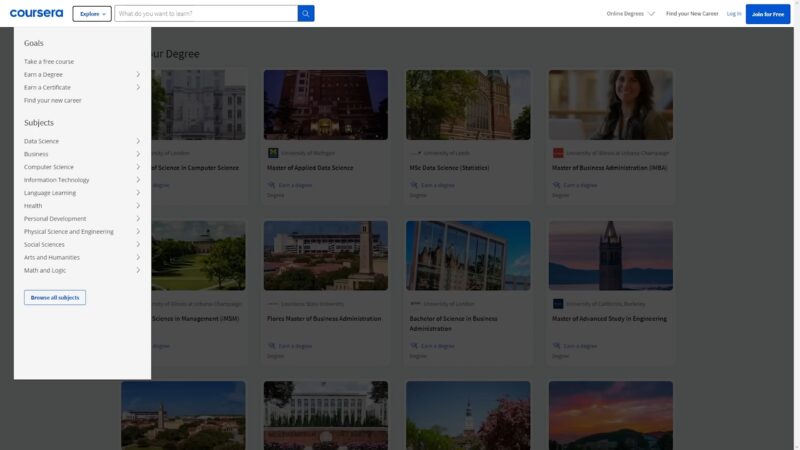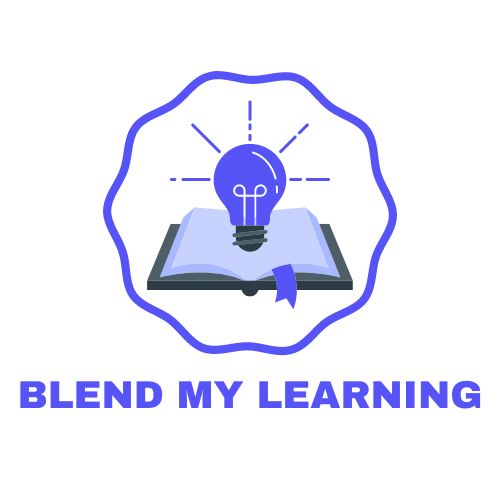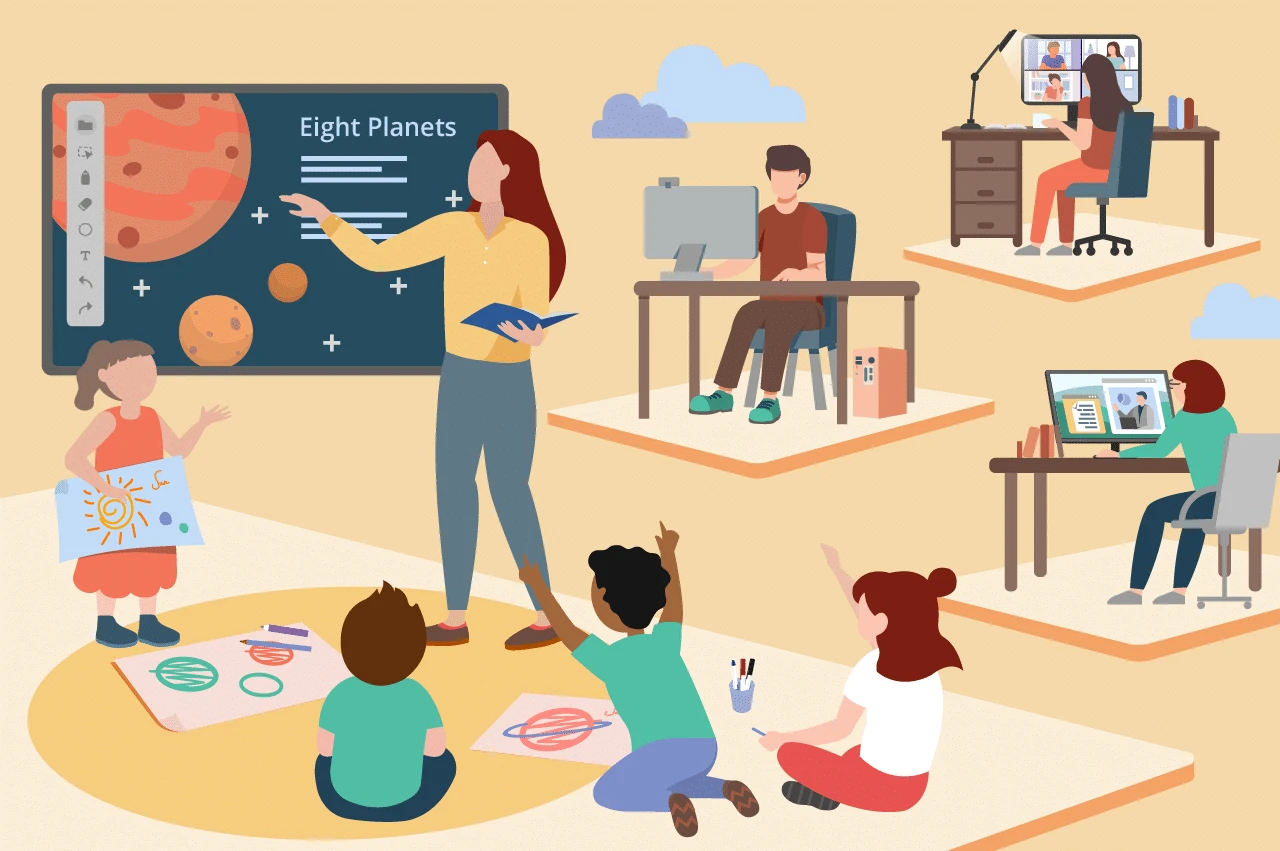Blended learning and e-learning are two prevalent approaches in modern education and training.
While e-learning occurs entirely online, blended learning combines digital learning with traditional face-to-face sessions.
These methods are crucial for optimizing educational strategies in today’s technologically driven world.
E-Learning

E-learning, or electronic learning, is a form of education that takes place entirely online through digital platforms.
Examples of e-learning platforms include:
These platforms offer a wide range of courses that learners can access from any location with internet connectivity.
One of the primary features of e-learning is its self-paced nature, allowing individuals to progress through the material at their speed.
Flexibility makes e-learning particularly attractive to working professionals, students in remote areas, and anyone seeking to learn new skills without the constraints of a traditional classroom setting.

E-learning often includes multimedia elements such as:
- Videos
- Interactive quizzes
- Discussion forums
Pros and Cons
First, let us talk about the benefits:
| Advantages | Description |
|---|---|
| Flexibility and Accessibility | Study anytime, anywhere; ideal for busy schedules; access for remote learners |
| Cost-Effectiveness | Lowers costs; requires only a computer and internet; many free or low-cost courses |
| Self-Paced Environment | Progress at own speed; review or skip topics; engaging multimedia (videos, quizzes, forums) |
And now let’s address the disadvantages:
| Disadvantage | Description |
|---|---|
| Lack of Direct Interaction and Feedback | Asynchronous communication leads to delays in feedback and less engagement. |
| Higher Dropout Rates | Requires high self-motivation and discipline, leading to lower completion rates. |
| Limited Practical Application | Insufficient for fields needing hands-on skills due to the lack of physical labs and supervision. |
Blended Learning

Blended learning, also known as hybrid learning, integrates online digital learning with traditional face-to-face sessions.
It is an approach involves a mix of synchronous (real-time) and asynchronous (self-paced) activities.
For example, students might complete online modules independently and then participate in in-person workshops or labs.
Blended learning aims to combine the best aspects of both online and offline education.
The online components provide flexibility and access to a wide range of resources, while the in-person sessions offer opportunities for direct interaction with instructors and peers.
The combination can lead to more comprehensive learning experiences, as students benefit from both the convenience of online learning and the engagement of face-to-face instruction.
Pros and Cons
The benefits of blended learning are numerous, but the most important ones are:
| Advantages | Description |
|---|---|
| Interactive and Tailored Experience | Combines online modules with in-person sessions, catering to different learning styles and needs. |
| Enhanced Engagement and Retention | Uses multimedia resources, interactive quizzes, and hands-on activities for better understanding and retention. |
| Regular Feedback | In-person sessions provide immediate feedback and clarification, crucial for understanding complex concepts. |
How about disadvantages?
| Disadvantage | Description |
|---|---|
| Higher Costs | Includes venue rentals, trainer fees, and materials, making it more expensive than online options. |
| Logistical Complexities | Requires careful planning to coordinate schedules and find suitable venues, especially for adult learners. |
| Higher Level of Coordination | Demands careful management of online and offline components, requiring instructor training and student adaptation. |
Key Differences
The next thing we want to address are the key differences:
Learning Environment

E-learning is conducted entirely online, providing a flexible and self-directed learning environment.
Learners can access course materials, submit assignments, and engage with peers and instructors through digital platforms.
The environment is particularly suited to individuals who need to balance their studies with other commitments, such as work or family.
In contrast, blended learning involves a mix of online and in-person components.
It creates a more structured environment, as students must attend scheduled face-to-face sessions in addition to completing online work.
The physical presence in a classroom can foster a sense of community and accountability, which might be missing in a purely online setting.
Learning Experience
The learning experience in e-learning is primarily self-paced and individual-focused.
Learners have the autonomy to manage their study schedules and progress through the material at their own pace.
It can be highly beneficial for motivated and self-disciplined individuals. It may also lead to feelings of isolation and a lack of immediate support.
Blended learning, on the other hand, offers a more interactive and immersive experience.
The combination of online and offline activities allows for a variety of learning modalities, including group work, discussions, and hands-on practice.
Peers and instructors in face-to-face sessions provide immediate feedback and support, enhancing the overall learning experience.
Feedback and Interaction

In e-learning, opportunities for real-time feedback are limited. While digital platforms may offer automated quizzes and peer-reviewed assignments, the lack of direct interaction with instructors can be a drawback.
Learners may have to wait for feedback or rely on asynchronous communication methods such as emails or discussion forums.
Blended learning addresses this issue by incorporating regular in-person sessions where students can receive immediate feedback from instructors.
These interactions promote engagement and allow for the practical application of knowledge.
The face-to-face components also facilitate richer discussions and more dynamic interactions, contributing to a deeper understanding of the subject matter.
Cost and Logistics

E-learning is often more cost-effective than blended learning, as it eliminates the need for physical classrooms, travel, and related expenses.
The reduced logistical challenges make e-learning an attractive option for organizations and individuals looking to minimize costs.
Blended learning tends to incur higher costs due to the necessity of in-person components. These might include venue rentals, trainer fees, and additional materials.
Despite these higher costs, blended learning can offer significant value through its comprehensive approach, combining the benefits of both online and face-to-face instruction.
Related Posts:
- Top Blended Learning Models for Effective Education…
- Step-by-Step Guide to Creating a Blended Learning Curriculum
- Top 10 Online Learning Platforms for Blended Education
- Essential Tools for Digital Literacy in a Blended…
- Interactive Activities to Enhance Engagement in…
- How to Incorporate Collaborative Learning in a…








